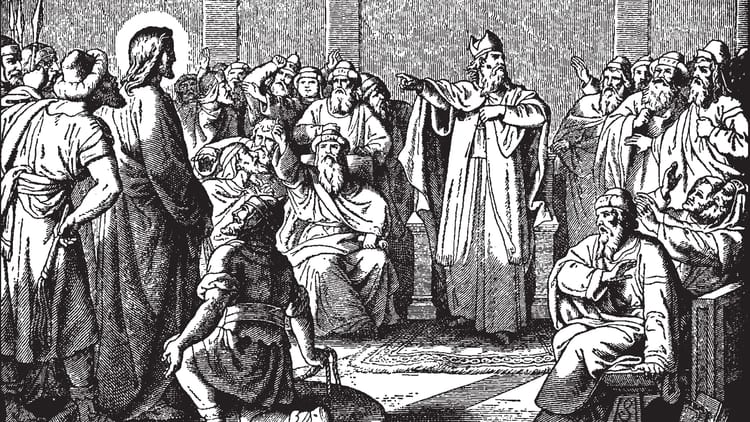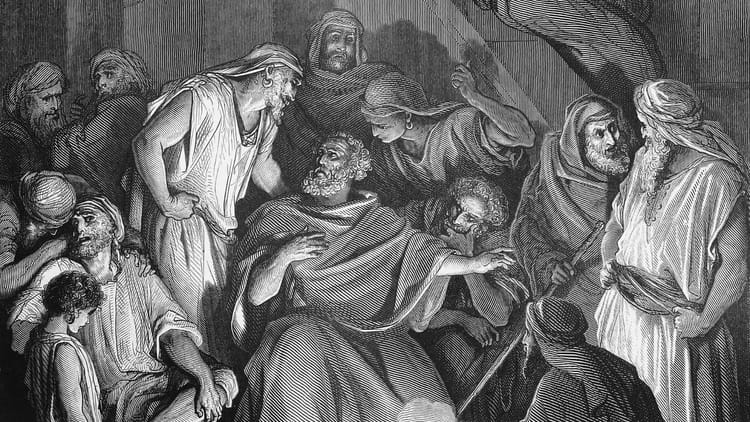Jesus and Hopeless Causes (Mark 4:35-6:6)

For the past couple of months, we’ve been looking at the Gospel of Mark. It’s the earliest record of the life of Jesus based on an eyewitness account. In case you’ve missed any of what we’ve looked at so far, let me catch you up. Jesus, according to Mark, is introducing the Kingdom of God to earth. He’s setting things right again, announcing the good news that God is on the move. He’s forgiving sins and healing diseases – but he’s also making lots of enemies. Mark is asking us to consider what we do with Jesus.
This morning’s passage is a long one. In this passage you have four miracles and then a story that concludes by framing a question that we need to answer in response to what’s happened. We could have looked at each of these separately, but then we may have missed what Mark is communicating by tying these stories together.
So let’s look at the four miracle stories, unpacking them a little, and then let’s conclude by posing two questions from this passage.
Let’s look at the stories, which are all stories of hopelessness, of being at the end of human resources.
In this passage, Mark introduces us to four problems, four sets of people who have one thing in common: they face impossible problems. I’m not talking about big problems. Good stories have conflict, and the point of the story is for the character to overcome that conflict or that problem, and emerge on the other side triumphant. We’re not talking about that kind of thing. The people that Mark introduces us to do not face big problems. Their problems are impossible. They’ve exhausted every human hope. There is no where else to turn.
What’s even better is that every one of the situations Mark describes is real. What do I mean by this? Many people read these stories and think they’re wonderful, but that they’re not real. But if you look at these stories carefully, you’re going to see that they have all the marks of being eyewitness accounts. Back in Mark’s day, things were written very differently than they are now. Details were never included that were not crucial to understanding what took place. Now, when we’re writing, we like to set the scene, and we include details that help the reader visualize what things were like. Back then, they didn’t do that. But here in this passage we have all kinds of small details that don’t seem to matter: that Jesus went into the boat just as he was; where he was sleeping in the boat; that he had a pillow; the age of the little girl that was raised; that Jesus told people to get her something to eat after she was raised from the dead. Why did Mark include all of these details? Either Mark invented a style of writing that didn’t exist before this time and wasn’t used again for hundreds of years, or else this is eyewitness testimony. What Mark records here are stories that really took place with actual details, which is remarkable as we look at them.
Each of these stories deal with huge problems, impossible problems, that go far beyond any human help.
First, we see the disciples facing a life-threatening storm. At the end of chapter 4, Jesus and the disciples decide to cross the Sea of Galilee. He’d been teaching from a boat; now they use a boat to get away from the crowds. As they cross, a terrible storm arose. The Sea of Galilee is almost 700 feet below sea level. Nearby are valleys that funnel wind onto the lake. You have coo air from the Golan Heights meeting warm air coming from the lake, which leads to very unpredictable weather, and storms with waves that are over seven feet high.
That’s exactly the situation that comes up in this passage. As they’re crossing, this storm comes up. We read in verse 37, “A furious squall came up, and the waves broke over the boat, so that it was nearly swamped.” They ask Jesus, “Teacher, don’t you care if we drown?” Don’t forget that you have professional fishermen on the boat. If you’re on an airplane and the person beside you is hyperventilating, you may think nothing of it if it’s somebody who has a fear of flying. But if you’re flying through a storm, and the person sitting beside you is wearing an Air Canada pilot uniform and he’s hyperventilating, maybe you decide it’s not such a bad idea to be scared yourself. Jesus and the disciples are on a storm that’s threatening to kill him. Storms are something that no human can control. We still call them acts of God. Only God can help someone caught in a storm on a lake like Jesus and the disciples were.
Second, we have a man who has an army of evil spirits tormenting him. We live in a modern age. Some of us read stories about demons and think that this is hopelessly primitive. It seems irrational and illogical to believe in demons. But if you believe in God who is both supernatural and good, as most people do, then why would it be illogical or irrational to believe in supernaturally bad forces? C.S. Lewis warned us that there are two mistakes we can make: one is to disbelieve their existence; the other is to feel an unhealthy and excessive interest in them. The gospels tell us that demons are real. They make a distinction between those who have evil spirits and those who are sick or even mentally ill. We still don’t understand a lot about demons, but there is every reason to believe that they exist and that they are destructive and dangerous.
In the case of this man, they were both dangerous and destructive. Demons destroy everything they touch. We read:
This man lived in the tombs, and no one could bind him anymore, not even with a chain. For he had often been chained hand and foot, but he tore the chains apart and broke the irons on his feet. No one was strong enough to subdue him. Night and day among the tombs and in the hills he would cry out and cut himself with stones. (Mark 5:3-5)
Here you have someone who has superhuman strength, who is isolated, self-destructive, and beyond any human remedy. In verse 9, when Jesus asks his name, he replies, “My name is Legion for we are many.” This isn’t just a man with one demon. You have a whole army here. A Roman legion consisted of some five to six thousand soldiers. You are dealing with an impossible situation here. To make it even worse, he was Gentile, which meant that he was not part of the people to whom God had committed himself. He was outside the community of grace.
Then, finally, you have two stories of people who are beyond medical help. At the end of chapter 5 we have two medical crises sandwiched together. Both have things in common: they’re both involve women; both have medical issues that are beyond human help; both are ceremonially unclean according to Old Testament laws, the woman because of her illness and the young girl when she dies. But what’s even more striking are the differences:
- one has a name; the other is nameless
- one is in a family of influence and means; the other is destitute
- one approaches Jesus openly; the other is hidden and approaches Jesus from behind
They’re different, but they’re not so different. In the middle of suffering, they reach the same place of hopelessness. In fact, the person with the advantages ends up even worse.
The stories are quite sad. The woman has been sick for twelve years. Verse 23 said that she had “suffered a great deal under the care of many doctors.” In those days, some of the treatments for her disease included boiling onions in wine, drinking it, and being told, “Cease your discharge.” The worst was eating barley grain from the dung of a white mule for three days. Not only had she been subject to these bizarre treatments, but she had spent all of her money on them and had grown worse. She would have been socially excluded and hopeless.
Then you have a young girl who dies while all of this takes place. Her father, a synagogue ruler, came to ask Jesus to come and heal her, but before he got there, she died. This is the ultimate person beyond any human help. You can’t do anything to help a dead person. Sadly, her condition wouldn’t have been unusual. Sixty percent of children who survived childbirth died by their mid-teens. More children died than survived. This is the ultimate hopeless situation. It doesn’t get any worse than dead.
Somebody said that this chapter should be named after St. Jude, the saint of hopeless causes. Mark is piling up these stories to give us a sample of situations that are beyond any human help, where there is incredible human suffering and nothing that anyone can do about it.
When you think about it, pretty much every type of problem we face is here as well: natural disaster, evil spiritual forces, sickness, financial problems, loneliness and isolation, and death. When I think of the problems I encounter as pastor, that covers pretty much all of them. If we could just get rid of these problems, our lives would be a lot easier.
I love the honesty of Scripture as well. Scripture is honest about the limits of human ability to fix every problem. There are many problems too big for us to fix. Some problems are beyond professional help. Human might, medical knowledge, and money can’t fix many problems. As in the case of the man who has evil spirits, you can’t even explain every problem. If you are facing a hopeless situation beyond any human help, this passage is for you.
So we have five hopeless situations here. But then:
Look at how Jesus shows that he has authority over all the hopeless situations that nobody else can help.
It’s almost humorous to see what happens when Jesus meets each of these situations. They’re hopeless situations, destructive and even deadly, and yet look at how easily Jesus deals with them.
In the storm, Jesus says, “Quiet! Be still!” You could translate this, “Be quiet and stay quiet.” It’s how you talk to a child. Immediately, it says, the wind ceased, and there was great calm. It was dead calm. Even when a storm stops, the water remains choppy. Here the water becomes as still as a pool before anyone jumps in it. Nobody can do this, but God can. Mark is showing us that Jesus has authority over nature; and because only God has this authority, he’s forcing us to confront the question the disciples ask in verse 41: “Who is this? Even the wind and the waves obey him!”
Nobody can deal with the demons that torment the man we encounter in chapter 5, but Jesus can. Instead of battling against Jesus, they immediately recognize his authority and beg again and again that they not be sent out of that area. These demons were out of control – until they encountered Jesus. Mark is showing us that Jesus has authority over demonic power. Jesus takes someone who is naked and demonized and transforms him into someone in his right mind, the first missionary to the Gentiles.
Then you have the woman who had a discharge of blood. Jesus didn’t even do anything to heal her. She touched him. She was ceremonially unclean, which meant that anyone she touched would become unclean. But instead, Jesus’ uncleanness made her clean. Mark is showing us that Jesus has authority over disease.
Then there’s the twelve-year-old girl who died. Jesus simply touches her hand and says, “Little girl, I say to you, get up!” and she does. What he says to her is remarkable because it’s so unremarkable. He says exactly what a mother would to a child on a sunny day when it’s time to get out of bed. And then Jesus tells them to get her something to eat. This isn’t the first time that a child was raised from the dead in Scripture, but when Elisha was used to raise a boy, it was much harder. Not only does Jesus have authority over nature, demons, and disease, he also has authority even over death. Every person in these stories is a victim of circumstances with no hope apart from Jesus. These problems are all beyond human help, but none of them are problems for Jesus. They almost seem inconsequential to Jesus in these stories that Mark offers us.
Mark is not saying that if you follow Jesus, he will calm all the storms and heal all the diseases and deal with all of your problems. That’s the last thing he’s saying. What he is saying is that all of these problems came into the world as a result of sin, as a result of what the first Adam did. And now Jesus is the second Adam, who is undoing the effects of sin. He has authority over all the forces of evil that stand against his kingdom. He has authority over all powers that are hostile to God and that destroy us.
Jesus not only has authority, but he used that authority to save us. The one who had authority over evil took on evil at the cross. He was stripped and made unclean so that we could be clothed and be made clean and in our right mind. He who raised the dead died himself so that he could destroy death and bring life and immortality to light through the gospel. He became unclean, so we could be made clean; he died so that we may live.
This leads us to the last story, and two questions we’re left to answer.
In chapter 6, Jesus returns to his hometown. Word of what Jesus did has reached them. They basically asked the same question the disciples asked when Jesus calmed the storm, back in Mark 4:41: “Who is this?” Look at Mark 6:2-3 as they react to his teaching and his miracles:
“Where did this man get these things?” they asked. “What’s this wisdom that has been given him? What are these remarkable miracles he is performing? Isn’t this the carpenter? Isn’t this Mary’s son and the brother of James, Joseph, Judas and Simon? Aren’t his sisters here with us?” And they took offense at him.
Jesus has divine authority over nature, evil, sickness, and death, which leads us to ask: who is he? The people in Jesus’ hometown – even in his own family – couldn’t accept the answer. They saw only a builder, the son of Mary, a village son who had returned for a visit. Jesus, we read in verse 6, was amazed by their unbelief.
We’re left with two questions as we conclude this passage. The first question has to do with where we turn with our hopeless causes. Many of us here face situations that are far beyond human help. We’re desperate like many of the people in this passage. We haven’t yet learned what Martin Luther wrote about in an old hymn:
Did we in our own strength confide
our striving would be losing;
Were not the right man on our side,
the man of God’s own choosing.
This passage reminds us that our hope isn’t in human strength. God won’t take away all our suffering and all of our problems, but he has authority over everything that opposes him and destroys us. He has divine authority over nature, evil, sickness, and death. This gives us great confidence as we suffer. We may not have all the answers, but we can know that God is in control, and that he will one day set all things right.
This passage leaves us with a second question. Who is this? We can answer as they did in his hometown – or, like the Gentile man whose demons were cast out, we can tell what Jesus has done for us. Like Jairus, we can come and plead with him, presenting our hopeless case before him and pleading for him to do something with it. Or, if we lack faith, we can approach him quietly from behind trembling in fear. It’s not the amount of faith that matters; it’s that Jesus is the object of our weak faith.
Jesus has divine authority over nature, evil, sickness, and death. Who is he? The answer changes everything.
Father, we pray for those who have insurmountable problems. Some of us have problems beyond human help. We bring them to you today. We thank you that Jesus has authority over nature, evil, sickness, and death. Thank you that he became unclean so that we could be made clean; that he died so that we could live.
Help us to answer the question: who is this? “Who is this? Even the wind and the waves obey him!” “Where did this man get these things?” May we come to understand who Jesus really is and what he has done. We pray this in Jesus’ name, Amen.





